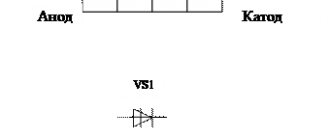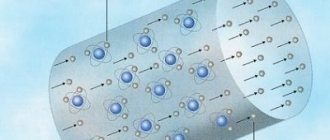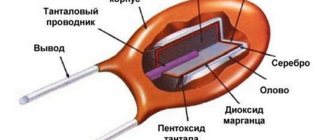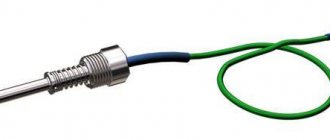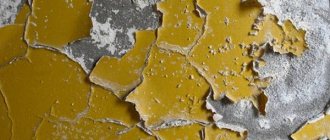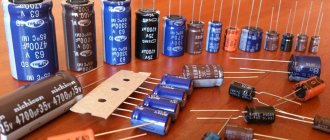Principle
The scheme by which metal electroplating is implemented is quite simple. It includes a product on which a protective coating is applied, a container with an electrolyte solution where the product is placed. The third participant in the process is a metal plate, to which a positive current charge is applied; it acts as an anode; the product placed in the solution becomes a cathode, where a negative charge is applied.
When the electrical network is closed, the metal of the anode (plate) dissolves in the electrolyte and, under the influence of current, rushes to the negatively charged product (cathode), thereby creating a durable coating. An electrolyte is a conductive solution for moving metals from the anode to the cathode. The size of containers (baths) with electrolyte varies, depending on production tasks.
Large products are placed on hangers through which a negative charge is passed; the structure is held suspended in the volume of the bathroom. Small products are galvanized in drum-type baths, where a large number of products are simultaneously galvanized. In this case, a negative charge is applied to a drum rotating in a container with electrolyte, where the anode is inserted.
There are bell-type filling baths, where galvanic coating is simultaneously applied to a large number of very small parts, for example, hardware. Products are poured into the container, the electrolyte composition is poured in, and the anode is installed. The baths are given a slow rotation, during which the products are evenly coated with protective metal.
Necessary equipment
Electroplating
Galvanic processing of small products at home requires certain equipment and chemical reagents. The main list of equipment includes:
- DC power supply;
- capacity;
- electrolyte;
- scales;
- electrodes “anode” and “cathode”;
- the wire;
- electric stove.
The source is used with current regulation. The rectifier, designed for output currents up to 5 A, is suitable for working with objects the size of an orange. For small cells, a current of up to 0.5 A is sufficient. 12 V chargers are also suitable for the electroplating process. The starter battery can serve as such a current source. To reduce the current, it is permissible to use shunting, connecting a resistor in parallel with the vessel.
When making a galvanic bath with your own hands, it must be spacious, durable and thermally stable. Ready-made glass products with a glass thickness of at least 4-5 mm, an old aquarium or a jar with a wide neck are well suited for these purposes.
Electrolyte is an aqueous solution of salts, prepared from chemical components depending on the desired coating.
To accurately select ingredients and maintain the proper concentration of the solution, you need a weighing device, preferably electronic.
Plates made of a donor metal of sufficient thickness and area are used as electrodes. The electrodes supply current to the electrolyte and also serve to replace the metal that is lost in it. The wires are multi-core, copper insulated, with a cross-section of at least 2.5 mm2.
An electric stove is required to heat the electrolyte. Increasing the temperature of the working solution speeds up the galvanization reaction time. The ability to adjust the heating is a prerequisite for selection.
Electroplating at home
Methods
The galvanic method of coating products allows you to create a durable protective coating on metals, isolating parts from the aggressive effects of working environments. Insulation can be created from various metals; application is carried out by anodic and cathodic sputtering.
Cathodic coating is characterized by the fact that at the slightest violation of the integrity of the applied layer, the metal underneath is destroyed more intensively, which is facilitated by the coating technology itself. An example of rapid erosion is tinned metal products, where tin serves as an insulating layer.
Anodic electroplating has different characteristics. When conditions arise that threaten corrosion, the galvanic insulation is destroyed and the metal remains intact for a long time. Anodized products are reliably protected from aggressive environments and mechanical damage. The most common type of insulation is galvanizing. The method allows you to preserve all the characteristics of the processed product, its appearance, shape and size.
Electroplating methods
The process of forming a protective film with another metal is carried out using two methods:
- Galvanic cathode sputtering. This metal coating technology is distinguished by the fact that if it is slightly disturbed, rapid corrosion of the main product occurs. This process is facilitated by the surface layer itself. An example is tin tinning.
- Galvanic anodic deposition. Refers to reliable galvanic coatings. When a threat of corrosion arises, destruction first begins in the surface layer. The base metal retains its original shape for a long time. At the same time, it is reliably protected not only from the external environment, but also from mechanical influences.
Goals
Galvanic coatings are divided into several types depending on the purpose of the product:
- Protective and decorative. The purpose of application is to obtain high aesthetic characteristics and protect products from destructive factors.
- Protective. They isolate metal parts from aggressive environments and mechanical damage.
- Special purpose. Galvanic coating is applied to obtain new properties - increased wear resistance, increased hardness characteristics, obtaining magnetic and electrical insulating properties of the finished product. In some cases, galvanization is used to restore the original appearance of a product or after long-term use.
Chromic anhydride
From a technical point of view, it is a combination of two substances such as chromium and oxygen. It is very often used in the chemical industry, and therefore is often called chemical acid. This substance dissolves quite well in water, which is excellent for use in workshops where most operations are carried out with liquid content to one degree or another. Chromic anhydride is currently most widely used in three areas: mechanical engineering, metallurgy, chemical and petrochemical industries. Depending on its purpose, this substance is produced in three categories: A, B and C.
- Grade A is used in cases where, under production conditions, it is necessary to obtain metallic chromium or other materials, but with sufficiently high hardness values.
- Grade B is used for the production of electrolytic chromium and in the production of catalysts. It is this anhydride that is used in electroplating shops.
- As for grade B, it is most suitable for raw material foundry operations.
Generally speaking, this type of workshop is extremely necessary, but at the same time quite harmful and dangerous. Because of this, all safety requirements must be met and the best ventilation must be installed.
Types of coatings
The galvanic coating method is implemented by applying various metals to the product, each of them has its own characteristics and purposes in the further operation of the part or object:
- Silver plating – increases aesthetic value, protects against corrosion, improves reflective and conductive characteristics. This type of application is in demand in the production of static relays, contactors, electromagnetic relays, electromagnetic starters, microcircuits and other electronic products.
- Nickel plating is the most popular galvanic coating of steel, copper and aluminum products. The nickel layer reliably protects products or machine parts from rust formed under the influence of the external environment, as well as from types of corrosion resulting from contamination of the working environment by aggressive media - alkalis, acids, salts. Nickel-plated products demonstrate high resistance to severe mechanical damage and abrasion.
- Chrome plating - increases the wear resistance and hardness of anodized surfaces, improves the appearance, and restores damaged parts to their original parameters. Depending on changes in the technological regime, a galvanic coating with different parameters and properties is obtained - matte gray (increased hardness, but low wear resistance), shiny (high wear resistance, hardness), milky plastic (aesthetics, high degree of anti-corrosion protection, low hardness), galvanizing – anti-corrosion treatment of solid steel sheets, car parts, construction and finishing materials.
- Electroplated gold plating - used in jewelry, electronics and other fields. The gold layer gives the parts high reflective properties, aesthetics, protection against corrosion, and increases conductive qualities.
- Copper plating - often used to coat metal to protect against corrosion; copper improves current-conducting qualities; metal with such a coating is often used for the production of electrical conductors used outdoors.
- Brass plating – used to protect steel, aluminum and alloys from corrosion damage. The brass layer provides the necessary adhesion of metal parts to rubber.
- Rhodium plating is a special coating applied to give parts high resistance in chemically aggressive environments and to obtain additional mechanical wear resistance. Rhodium plating also adds decorative value to products and protects silver items from oxidation and dullness.
Regulation of the quality and technological processes of galvanic coating occurs using GOST 9.301-78.
Purposes of Metal Electroplating
Capacitor energy
What is electroplating for household use? Theoretically, it is not too difficult to find a specialized enterprise, conclude an agreement, and receive a finished product with official guarantees. However, the practical implementation of such ideas is associated with various difficulties:
- payment for services and loss of time;
- lack of good specialists or relevant industries nearby;
- the reluctance of performers to reconfigure existing equipment to perform a relatively small amount of work.
Only you can create a unique electroplating with special characteristics yourself. Technology opens up vast opportunities for individual creativity. As will become clear after studying the data presented in the publication, the technology can be reproduced with high quality without excessive costs.
Galvanic coating provides an impeccable appearance for products with complex shapes
The photograph clearly demonstrates the excellent quality of processing of the smallest details and hard-to-reach areas. In addition to improving aesthetic parameters, metal electroplating helps create a layer of low electrical resistance on the insulator.
Stainless steel is expensive. Instead, the resistance of products at high humidity is increased with the help of copper plating. The technology is suitable for the production of spectacular jewelry, decorative and functional furniture elements. With its help, miniature parts are strengthened and chemical neutrality is ensured.
In cosmetology, low-intensity galvanic discharge is used to improve the functional state of the skin and remove individual defects.
Preparatory stage
Electroplating is a multi-level technological process implemented in three main stages (preparation, coating, final processing of the finished product).
Preparing surfaces for further galvanization is the most labor-intensive and critical stage of the entire process. The quality of the resulting protective coating depends on the correctness and sufficiency of its implementation. If there is the slightest trace of grease and oxide film on the metal surface, it will be impossible to obtain a homogeneous continuous protective film - the coating will not be able to penetrate the layers of the base metal, bubbles, tears, etc. may form.
Defects can occur in places where burrs remain, surface unevenness, in places of poorly polished joints, in places that are not sufficiently cleaned of dust. Electroplating requires low surface roughness, thorough cleaning after grinding and mandatory treatment with degreasing agents.
Where and for what is the galvanizing method used?
Galvanics (a branch of the science of Electrochemistry that studies the deposition of electrolyte on the surface of a metal) includes 2 full-fledged sections: galvanoplasty and galvanostegy. Both involve the direct process of metallizing the surface of products to obtain copies and protection:
- anti-corrosion galvanic coating (technological chrome plating, galvanizing, etc.);
- decorative protection (aesthetic coating of jewelry with precious metals);
- imparting strength to products made of soft metals and plastics.
In the last two cases, galvanic growth of a thicker layer of metal deposits is used - electroplating with silver, gold or their imitation. Electroplating has “found itself” in nickel plating, copper plating, chrome plating, tinning, copying, metallization of plastic and stone, in the production of souvenirs, wherever electrochemical coating of another material that is mechanically stable with metal is required.
The most profitable example of electroplating is the production of computer CDs; vinyl records were once mass-produced using a similar technology.
The galvanic method of applying metal to a selected surface allows you to obtain a uniform metal film on parts of any complexity. And the film will be the same thickness over the entire surface!
On video: master class on galvanizing.
Types of parts processing
Mechanical processing and achieving ideal smoothness of metal parts is achieved at home by grinding the surface with sandpaper and other abrasives; on an industrial scale, sandblasting, chemical, and automated methods are used to achieve results. At the preparatory stage, parts or individual areas that are not subject to galvanization are insulated.
Depending on the type of metal being applied, different preparations are carried out. Before galvanizing or cadmium plating, the surface of the part to be protected is degreased and pickled. Chrome and nickel plating is preceded by mechanical grinding, degreasing, and removal of the oxide film. Degreasing is carried out in two stages - starting work and complete degreasing.
The parts are first washed with solvents - white spirit, gasoline, special organic mixtures, etc. The final treatment is carried out using alkaline solutions or the electrochemical method. After which the parts are washed with hot water, the metal is activated and lightly etched to remove the smallest films of oxides, which improves the adhesion of the surface of the part with the galvanized metal coating.
Types of basic galvanic coatings
Chrome plating
A layer of chromium is applied to the surfaces of steel bolts, axles, measuring tools, etc. to impart increased hardness and increase the corrosion resistance of metals such as copper and nickel. A triple “sheep coat” is often found: the base is copper, then nickel, and then chrome. They are also used as decorative sprays.
Galvanizing
Zinc is not only resistant to atmospheric influences, but also, being an anodic metal, provides parts with increased mechanical and electrochemical protection. Galvanizing can be shiny, as is the case with chrome, or it can have a matte surface, which does not affect its resistance to dirt and corrosion.
Has come or is coming
This is the name given to galvanic coating of “weak” metals with iron. For example – copper. Parts and elements made of this red metal wear out very quickly. Coating them with galvanic iron gives them the hardness of steel, and the light-silver film of such iron practically does not rust.
Electroplating of aluminum alloys
Such alloys are galvanized in order to combine a number of valuable qualities of aluminum and coating. For protective and decorative functions, aluminum will be electroplated using a combined alloy of copper, nickel and chromium. To impart antifriction properties to machine parts (bushings, bearings, and other parts that operate while sliding), galvanization of lead and tin or tin and copper is used.
To speed up the soldering of aluminum parts, the galvanic coating should be tin or silver. Brass – for adhesion of aluminum to rubber (hot pressing). Galvanizing prevents jamming of threaded parts made of aluminum. The pairing of components is aluminum + steel or copper - cadmium.
Galvanic etching
This is the only method of electroplating that uses alternating rather than direct current. In addition, the “rite” of etching (painting a picture on the desired object) is easy to carry out at home. To do this, you will need a galvanic bath (any suitable plastic container), a transformer capable of reducing the current to 6V, 2 copper and iron plates and 2 metal rods.
The etching process is carried out as follows:
- Heat the plates slightly and cover with a thin layer of wax or paraffin. Apply any desired design to the wax surface.
- Hang the plates “facing” each other on rods at a distance of 1.5-2 cm.
- Pour a solution of ordinary table salt into a plastic container (2-3 tablespoons per 1 liter of water) and apply voltage.
- After 40 min. turn off the current, remove the plates, wash them and carefully heat them to a temperature where the wax can be easily peeled off without scraping.
Now we are happy to examine the galvanic pattern etched on the plates - an exact copy of the previously applied pattern. This, of course, is not airbrushing on the body of your favorite car, but you can definitely etch your own pattern on the blade of a hunting knife!
Today it is no longer possible to do without galvanization. Damaged and scratched earrings, rings and pendants are subjected to silver plating, gilding, and rhodium plating. Chips and holes are filled, the surfaces of parts and car bodies are leveled. In plumbing stores we admire shiny faucets, choose chrome pipes and ask the price of gold-plated cutlery. And all this is because almost all industries have adopted the Boris-Moritz-Jacob-Hermann method.
Homemade electroplating (1 video)
Parts with galvanic coating (20 photos)
How the process works
The deposition of a protective layer of metal on products is carried out using special equipment. Differences in the application of types of electroplating are reflected in the formulation of the electrolyte used.
The galvanic method of coating metals and other materials occurs as follows:
- Galvanic baths are filled with an electrolytic solution. Anodes and workpieces are placed in them. The size and type of bath depend on the size of the parts requiring coating.
- The heating device brings the temperature of the electrolytic composition to the required technologically justified value.
- The design is supplied with current from a source equipped with a voltage regulator.
- The galvanic coating process takes a certain time, its value is determined by the size of the part and the achievement of the required thickness of the protective layer.
Electroplating Process
Electroplating first appeared in 1836. It was discovered by the Russian physicist Jacobi. He conducted a series of experiments and found out that after passing metals through aqueous and salt solutions under the influence of electric current, positively charged ions settle on the cathode. When passing through salt solutions with the help of an electric current, metals disintegrate into ions that have different charges. Those that have a negative charge are deposited on the anode. Those that have a positive charge are deposited on the cathode. Its role in galvanizing is played by metals that need to be protected from corrosion.
The electroplating process is quite simple from a physical point of view.
It consists of three main stages:
- Surface preparation. At this stage, it is necessary to carefully prepare the metal surface for the galvanizing procedure. To do this, you first need to remove all dirt from it and carry out the degreasing process. Then it is necessary to rinse the surface with water and treat it with means to stop the oxidation process.
- Electroplating. After all the preparatory procedures, the process of immersing metal parts in galvanic baths begins. They contain a metal alloy that will cover the surface. The entire procedure is carried out at high temperatures. In this case, the magnitude of the electric current is maintained at a certain level.
- Processing of metal-coated material. At the final stage, tests are carried out to determine the level of adhesion of the metal alloy to the surface.
Process Features
In some cases, with the galvanic coating method, the workpieces are hung on a cathode rod located in the bath, and plates of the metal that will coat the products are placed on the anode rod. To obtain certain characteristics of the coating, metal salts, organic compounds, brightening agents, etc. can be introduced into the electrolyte.
To speed up the process of metal transfer, the electrolyte is stirred, which makes it possible to use a higher current density. Reversing the direction of current allows you to obtain a smooth surface.
The exact duration of the galvanic coating process is established experimentally - by applying a protective layer to the part, measuring the thickness of the resulting layer over a certain period of time under given process conditions. At the adjustment stage, special attention is paid to the thickness of the layer in the recesses and cavities of the experimental part being processed.
What is the galvanization process
Having found out what electroplating is, you can begin to study the important details. If a cathode is used for deposition, the anode is selected from the appropriate material. The principle of operation is gradual destruction to replenish the loss in the solution of working ingredients.
Electroplating at home
The composition of the medium must be selected in such a way as to minimize (completely eliminate) deterioration in the quality of the coating due to the presence of certain impurities. The following factors must also be taken into account:
- to increase the efficiency of useful physical and chemical processes, increasing temperature is useful;
- you will need a fairly powerful DC source;
- In order not to perform some actions manually, control and automation tools are needed.
Important! Since it is planned to organize production at home, it is necessary to pay special attention to safety issues.
Layer thickness
The thickness of the galvanic coating is determined according to data on the average thickness of the applied layer and depends on the conditions in which the part will be used. They are divided into groups:
- Light conditions (LC) - parts are used in closed heated rooms with a relatively dry atmosphere, or the product will be used for a short period of time in an external environment where there are no active corrosive agents. The thickness of a single-layer coating is about 7 microns, a multi-layer coating is 15 microns.
- Average Conditions (AC) - Parts will be used in environments with average humidity, pollution, small amounts of fuel, industrial emissions or seawater vapor. The thickness of a single-layer coating is 15 microns, a multi-layer coating is 30 microns.
- Severe conditions (HS) - involve the operation of parts in conditions of high humidity, increased levels of pollution with industrial gases, fuel waste, solids, and dust. The thickness of a single-layer coating is 30 microns, a multi-layer coating is 45.
Data on the thickness of galvanic coating of parts in one layer is contained in GOST 2249-43. This includes zinc coatings. Controls multilayer application of galvanic coating GOST 3002-45 (nickel coatings). The thickness of the layer can be changed according to design requirements or in cases where the workpiece is designed for a short service life. The service life of galvanizing is up to 5 years, for other types of coatings – up to 3 years.
Special purpose devices
Electroplating production requires special-purpose baths that are designed to work with small parts.
The first equipment of this type is a bell bath. The main difference between this type of device and the main one is that it has a special bell, and the main purpose is to apply galvanic coating to small parts in bulk form. The bell itself is truncated and has a multifaceted design. Such a device is used both as a stand-alone machine and in a line.
Electroplating production periodically requires equipment such as a galvanic drum. It is a prism, which is made of either PVC or polypropylene, which has many edges, all of which are perforated. To rotate such a prism, a motor with a gearbox is used, and torque is transmitted through a gear-type wheel system. The drum can be used in manual, automated and mechanized line types.
Processing of the finished product
Galvanic coating of parts is completed by an additional processing stage. The following operations are implemented in this process:
- Lightening.
- Painting with paints and varnishes.
- Passivation.
- Dehydration.
- Oiling or polishing.
- Performing silver plating with anti-tarnish compounds.
Lightening and passivation increase the anti-corrosion properties of galvanized products and cadmium coatings. The passivation process is the immersion of products in a special solution, which forms a protective film up to 1 micron thick on the surface of the part.
Products made of steel and copper with galvanic coating are additionally treated with oils - oiled. This is done in order to improve the protective qualities of metal insulation and helps to increase anti-corrosion resistance.
Features of galvanization with various metals at home
Below are the nuances that should be taken into account when reproducing individual technologies.
Nickel plating of metal products
For this process, an increase in temperature (from +24°C to +26°C) and galvanic current up to 1.2 A per dm2 is used, compared to the silvering presented above. The pH value is carefully monitored. The recommended pH range is from 3 to 6. A durable layer will have time to form in 30-40 minutes.
Copper plating without immersion
The steel product is fixed in a holder and connected to a direct current source (minus). A brush made of stranded copper wire is dipped in electrolyte. This instrument is connected to the positive. It is driven over the treated part of the surface.
Electrochemical galvanizing
The electrolyte is created from the following ingredients:
- distilled water – 2 liters;
- ammonium sulfate – 100 g;
- zinc sulfate – 400 g;
- sodium acetic acid – 30 g.
Treatment lasting 30-40 minutes will create a durable layer that well protects parts from corrosion. This method is cheaper than using similar stainless steel parts.
Chrome plating of metal products
For reliability, this layer is fixed on a technological nickel substrate. This solution does not form a galvanic couple. Increasing the temperature increases the shine of the decorative coating. Durable coatings are obtained at a current density of more than 90 A per dm2, which is difficult to achieve at home.
Quality control
Requirements for the quality of galvanic coating depend on the operating conditions of the processed product. To assess application, the following types of control are used:
- Assessment of the appearance of a part through visual inspection, comparison with reference samples (surface cleanliness, color, presence or absence of gloss).
- Determination of the thickness of the galvanic coating and porosity is carried out in laboratory conditions (measurement).
- Corrosion resistance according to TU or GOST (test).
- Mechanical, physical stability (reflective properties, ductility, wear resistance, electrical and temperature resistance, hardness, etc.)
Electroplating method
In the modern world, the galvanic method is often used when processing metal surfaces. Electroplating of materials involves applying a thin metal layer to their surface. In this case, a film of small thickness is formed, which resists the oxidation of individual metals. The galvanic method is used to give a product or material:
- strength,
- wear resistance,
- resistance to corrosion,
- attractive external qualities.
In the modern world, this method of processing metal coatings has become very popular because a large number of requirements are placed on equipment and other products. It is required to constantly increase the strength of individual parts and increase their resistance to the influence of an aggressive external environment. Metal parts in modern production must be able to withstand temperature changes. This is the reason why many industries widely use the galvanic method of processing metal products.
Important: The thickness of the galvanic coating is quite thin with the electroplating method. It ranges from 6 to 20 microns. It depends on the materials that are used for the electroplating process.
Due to their durability, galvanic coatings are widely used in such industrial sectors as:
- aircraft manufacturing,
- mechanical engineering,
- construction industry,
- radio engineering industry,
- electronics industry.
Advantages
The advantages of this method of protecting metal products include:
- High anti-corrosion qualities.
- Resistance to mechanical and physical damage.
- Resistance to aggressive environments of natural and industrial origin.
- Low porosity of the coating.
- Hardness, wear resistance.
- Possibility to adjust the thickness of the applied coating during the application process.
The disadvantages of the method include high energy consumption, environmental hazards, and the high cost of cleanup measures.
Electroplating for various metals
Zinc plating, brass plating, silver plating, nickel plating and chrome plating are all methods of coating one metal with another as a result of an electrochemical reaction. Depending on the desired result, you can obtain the required coatings at home using the same galvanic installation.
Nickel plating
This is the deposition of nickel atoms as a coating on the workpiece. Two nickel plates are taken as an anode and immersed in a bath of electrolyte at the same distance. Between them, a nickel-plating object is placed on a suspension. The sulfuric acid composition of the electrolyte includes:
- 140-200 g/l nickel sulfate (NiSO4);
- 50-70 g/l sodium sulfate (Na2SO4);
- 30-50 g/l magnesium sulfate (MgSO4);
- 5-10 g/l sodium chloride (NaCl);
- 25-30 g/l boric acid (H3B03).
All components are diluted with warm distilled water (20-25C0) in the required proportion. After dissolution, add water to the required volume. The acidity of the solution is 5.0-5.5 pH, with a flowing current density of 0.5-0.9 A/dm2. The minimum nickel plating time is 15-20 minutes. The thickness of the layer is directly dependent on the current strength, area of the part and exposure time.
Necessarily. Upon completion of work at home, the remaining electrolyte is washed off with running water, and the parts are wiped dry.
Nickel-plated parts
Chrome plating
Another shiny metallic finish is chrome. To prepare electrolyte for 1 liter of distilled water you need to take:
- chromic anhydride (CrO3) – 250 g;
- sulfuric acid (H2SO4) with a density of 1.83 g/cm3 - 2.5 g;
- distilled water, heated to 60 0C.
A current of nominal value is passed through an aqueous solution with an acid and anhydride mixed in it for 4 hours. until the electrolyte turns dark brown. After this, it sits for 24 hours and is ready for use.
Copper plating
Copper has a beautiful red hue. The part also acquires this color after galvanization. There are two options for copper plating: with and without immersion of the workpiece.
Immersion method
This is an already considered galvanization option with placing the part in an electrolyte solution. Copper plating is performed in the following sequence:
- 20 g of copper sulfate powder is added to the electrolyte for a car battery and mixed thoroughly;
- two copper sheets are lowered into a bath of electrolyte at a distance from each other, and the part to be copper-coated is placed between them;
- a direct current source with a voltage of 4-6 V is connected with its “minus” to the workpiece, and its “plus” - to the copper electrodes;
- The power supply regulator sets the current at the rate of 15 mA/cm2.
Process the part for 15-20 minutes. until the desired coverage is achieved.
For your information. Copper plating is used both as a separate decorative finish and as a preparation of the surface for further chrome plating or silver plating of the part. The method is also applicable for the manufacture of bimetallic structures.
Copper plating without immersion
In the case of surface processing of objects that do not fit into the container, this method can be used. Its essence lies in the fact that the part on which the copper layer will be applied is connected to the “minus” of a 6 V power supply (no more). A stranded copper wire, fluffed at the end like a tassel, is connected to the “plus”.
The “brush” is periodically moistened in the prepared electrolyte solution and the surface to be copper-coated is covered with it, while maintaining a minimum gap between the surface and the “brush”. Copper ions will be attracted to the negatively charged workpiece and settle on it. Alternatively, you can use a watercolor brush with a metal bristle clip.
Copper plating without immersion in a galvanic bath
Aluminum processing
Electroplating when working with aluminum objects at home is not practical. Aluminum and its alloys have a permanent oxide film that prevents the donor atoms from adhesion to the base. Even if it is removed, the increased electronegative potential of this element contributes to the displacement of aluminum ions from the surface even before the onset of electric current through the solution, which also interferes with the normal connection of the base with the coating; pre-galvanization will not help either.
Gilding and silvering
The mirror is a clear example of applying a silver coating to glass. Products made of copper, brass and their alloys are well susceptible to silver plating. At home, the workpiece is first coated with nickel, then silver-plated. The electrolyte solution for silvering includes:
- potassium iron cyanide – 40 g;
- soda ash – 40 g;
- ammonium hydroxide solution – 70 ml;
- silver chloride – 10 g;
- sodium chloride (salt) – 15 g;
- distilled water – 1 l.
A graphite construction pencil rod is used as an anode.
Do-it-yourself electroplating can also help you turn copper into gold by applying gilding. This is done in the following order:
- 60 g of sodium phosphate (Na₂HPO₄) is dissolved in 700 ml of distilled water;
- 2.5 g of gold chloride (Au₂Cl₆) is mixed in 150 ml of highly purified water;
- 1 g of potassium cyanide (KCN) and 10 g of sodium sulfate (Na₂SO₄) are diluted in 150 ml of water.
The resulting solutions are mixed and heated to 60 °C. At this temperature, the further gilding process takes place. To prevent electrolyte depletion, a lead anode is used.
Attention! The reagents are hazardous to health. When working, observe increased safety measures and use personal protective equipment. The galvanizing table must have forced local ventilation.

